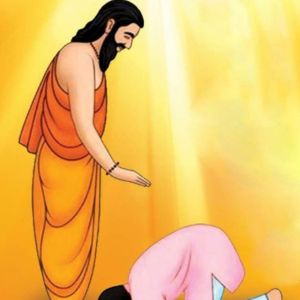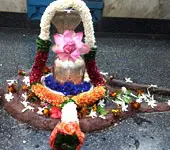Satyavati
Satyavati is an incredible character from the Mahabharata. She was a powerful woman with immense influence in Kuru Vamsha. Her remarkable deeds are worth discovering!
In Mahabharata, Satyavati (सत्यवती) was the paternal great grandmother of the Pandavas and Kauravas.
Satyavati's family
Father - King Vasu (वसुः) of Chedi also known as Uparichara.
Mother - Adrika (an apsara turned fish)
Foster father - Dasharaja (a fishermen chief)
Brother - King Matsya
Husband - King Shantanu of Kuru Vamsha.
Sons - Vyasa (from Parashara), Chitrangada, and Vichitravirya (from Shantanu).
Grandsons - Dhritarashtra, Pandu, and Vidura.
Great-grandchildren - Pandavas and Kauravas.

Who was Satyavati in her previous birth?
Satyavati was a divine being called Acchoda in her previous birth.
She belonged to the clan of forefathers called Barhishada-Pitrus.
She engaged in intense tapas.
The forefathers came before her.
She got attracted towards one among them called Amavasu.
The forefathers realized this.
They cursed her to take birth on earth.
They told her that she would be released from the curse after she marries King Shantanu and gives birth to two sons.
She would also give birth to an incarnation of Lord Vishnu fathered by Sage Parashara.
After completing her stay on earth, Satyavati returned to Pitruloka.
She is now worshiped as Ashtaka.
How Satyavati was born
Vasu was a king.
He wanted to get moksha and went to do tapas.
Indra persuaded him to come back and take over as the king of Chedi. By that time, Vasu had acquired a lot of spiritual power.
Indra also gifted him a vimana (chariot that can fly) and the Vaijayanti-mala.
In his vimana, he used to fly all over his kingdom and observe what was going on.
Because of this, he was also known as Uparichara.
King Vasu married Girika.
Before their marriage was consummated a distant part of the kingdom was attacked by wild animals.
The king had to leave all of a sudden to hunt them down.
Even though he was away, his mind was filled with the thoughts of his bride.
As he fantasized, his semen came out.
People of those days realized that the purpose of the male-female union was primarily for procreation.
Semen is the essence of the whole body and spirit as per the Vedas.
King Vasu did not want his semen to go to waste.
So he put the semen in a leaf cup, called a falcon, and told him to carry it to the queen.
She could make use of it and conceive.
If you may recollect, Sage Bharadwaja had also collected in a leaf cup his semen which came out when he saw an apsaras.
From this Dronacharya was born.
The falcon carried the leaf cup with the king's semen towards the capital.
On the way, another falcon saw him and thought that he must be carrying some food.
They both fought mid sky.
The semen fell into the river below.
Brahma had cursed an apsara called Adrika to become a fish.
She was in the river below and the semen fell right in front of her.
She swallowed it and became pregnant.
When Adrika (the fish) completed ten months of pregnancy, she was caught in the net of fishermen.
When they cut her open, there were two children inside, a boy and a girl.
The girl was Satyavati.
The fishermen took the twins to King Vasu.
The king realized that they were his children.
He accepted the boy and told the chief of the fishermen (Dasharaja) to bring up the girl as his own daughter.
Why did the king do that?
King Vasu had great spiritual power that he had developed through tapas and the blessing of Indra.
Sitting at his palace, he could see whatever was happening in all three worlds.
He knew the past, present, and future.
As soon as he saw the girl, he realized that it was none other than the rebirth of Acchoda.
She was to give birth to an incarnation of Lord Vishnu.
The mysterious way in which it was to happen could take place only if she is brought up as an ordinary girl among fishermen.
How did Satyavati get the name Matsyagandha
Since she was born out of the pregnancy of a fish, she had the smell of fish.
So she was called Matsyagandha.
Satyavati grew up among the fishermen on the banks of river Yamuna.
She also used to help people by ferrying them across the river.
Satyavati and Parashara
There is false propaganda that when Sage Parashara saw beautiful Satyavati, he lost all control and wanted to enjoy with her.
Nothing can be farther from the truth.
Here's why:
Mahabharata doesn't say anything like that.
Vyasa is the author of Mahabharata.
Parashara is his father and Satyavati is his mother.
Do you think he would write something so scandalous about his own father and mother?
Vyasa knows that he is an incarnation of Bhagavan and he is writing about his own birth.
Do you think he would write about his own birth in such a mundane and silly way?
This is how it actually unfolded:
Parashara knew that it was his responsibility to father an incarnation of Lord Vishnu (Vyasa).
He was a very accomplished tapaswi.
Nothing was hidden from him.
He also knew that this incarnation would take birth out of the womb of King Vasu's daughter who would later become the queen of Kuru Vamsha.
Parashara was on a pilgrimage.
He came to the banks of Yamuna and saw Satyavati.
As soon he saw Satyavati he recognized her as the daughter of King Vasu.
This is obvious from the following shloka of Mahabharata:
दृष्ट्वैव स च तां धीमांश्चकमे चारुहासिनीम्।
दिव्यां तां वासवीं कन्यां रम्भोरुं मुनिपुङ्गवः।
Parashara is being called धीमान् (Wise) and मुनिपुङ्गवः (greatest among Munis).
Satyavati is being called दिव्या (divine) and वासवी (Vasu's daughter).
Of course, Kamadeva has to play his role if a male-female union is to happen.
Parashara realized that time had come to plant his seed in the womb of Satyavati to facilitate the incarnation of Sri Hari.
Three more terms used in Mahabharata further establish this point.
Parashara says:
- संगमं मम कल्याणि कुरुष्व - sangama means union. It has no connotation indicating pleasure.
- उवाच मत्प्रियं कृत्वा कन्यैव त्वं भविष्यसि - fulfill my desire.
What can be the desire of an accomplished tapaswi?
Not enjoying with girls whom he meets during a pilgrimage.
Parashara, if he desires so has got the power to call or even create an apsaras.
His desire was to accomplish the task of bringing to earth the incarnation of Lord Vishnu who would help in maintaining dharma.
Later it is said - जगाम सह संसर्गमृषिणाद्भुतकर्मणा - Here also the term used is samsarga indicating that the primary purpose of their union was sarga or creation.
Had it been for enjoyment, sambhoga, rati or similar terms would have been used.
What Parashara did was an adbhutakarma, a miracle, not just coitus.
What was miraculous about it?
Satyavati started ferrying Parashara across the river.
Parashara informed Satyavti about the task ahead.
She had some apprehensions.
I am a disciplined daughter.
If I lose my virginity, how will I explain it?
Parashara told her that despite giving birth to a child, she will remain a virgin.
There are people on both the banks of the river.
What if they see us?
Parashara created fog to hide themselves.
Satyavati completed her pregnancy instantly and delivered a baby in an island in the middle of the river.
The baby (Vyasa) also instantly grew up and became an adult.
As a reward, Parashara replaced the odor of the fish from Satyavati's body with a fragrance that could be felt from a yojana away.
Thereafter, Satyavati became known as Yojanagandha, Gandhavati, and Gandhakali.
Satyavati continued to live as a virgin along with her family.
Satyavati weds Shantanu
Ganga, Shantanu's wife had left him leaving behind their son Bhishma.
Shantanu once saw Satyavati on the banks of Yamuna and liked her.
Shantanu approached Dasharaja seeking her hand in marriage.
Dasharaja said: I will be happy to do that, but I have a condition.
My daughter's son should inherit the kingdom from you.
Shantanu went back dejected.
How can he sideline Bhishma?
But Bhishma was his only son.
A Kshatriya should be ready to take up arms any time. What if something happens to Bhishma?
That will be the end of the great Kuru-Vamsha.
This was the reason Shantanu wanted to marry again.
But depriving Bhishma of his right would be highly unfair.
When Bhishma saw his father in a pitiable condition he became ready to give up his right to the throne.
He went and met Dasharaja.
Dasharaja told Bhishma: Satyavati is in fact, the daughter of Rajarshi Vasu.
He has told me that none other than Kuru king Shantanu could be a suitable husband for him.
But he already has a son which is you.
Satyavati's sons will never be able to prove themselves to be better than you.
There is no one better than you.
Then what will be their future?
Bhishma declared in front of everyone that Satyavati's son shall be the future king of Hastinapur.
Dasharaja: I trust you.
You are a man of words. But what about your sons?
What if they stake a claim for the throne?
At that moment Bhishma made his famous shapatha: I will remain a brahmachari throughout my life.
I will never get married.
Bhishma himself took Satyavati (his mother-to-be) to Hastinapur in his chariot.
The marriage of Satyavati and Shantanu took place.
Satyavati's sons
Satyavati had two sons - Chitrangada and Vichitraveerya.
After Shantanu, Chitrangada became the king.
Under the guidance of Bhishma, he defeated many kings and expanded his kingdom.
A Gandharva challenged Chitrangada.
They fought for three years in Kurukshetra and Chitrangada got killed.
Vichitraveerya who was still very young became the king.
Bhishma ruled on his behalf with the support of Satyavati.
The king of Kashi had three daughters: Amba, Ambika, and Ambalika.
Their swayamvara was organized.
Bhishma brought them by force as brides for his brother, Vichitraveerya.
This was permitted in Kshatriya-dharma.
Amba went back. Ambika and Ambalika stayed on.
After seven years, Vichitraveerya died of Tuberculosis.
Kuru-Vamsha comes to a crisis
Both sons of Satyavati have died childless.
Bhishma has taken a vow not to get married.
Satyavati tried hard to persuade Bhishma to become the king and take the wives of his brother as his queens.
Bhishma did not relent.
Satyavati disclosed to Bhishma that she had another son from Parashara.
Vyasa performs niyoga
Vyasa at the time of his birth itself had promised that whenever his mother remembers him he would come to her.
Satyavati remembered Vyasa and he appeared.
She convinced Vyasa to impregnate either of the wives of Vichitraveerya for the sake of the continuation of the vamsha.
This is called niyoga.
Later Satyavati convinced Ambika.
When Vyasa united with Ambika, she had kept her eyes closed out of fear.
Vyasa's form was frightening.
Her son (Dhritarashtra) will be born blind because of this.
When Vyasa told Satyavati this, she asked him to impregnate Ambalika.
Ambalika went pale when she saw Vyasa.
Her son (Pandu) was born pale.
After the birth of Dhritarashtra, Satyavati asked Vyasa to impregnate Ambika again.
Ambika sent her maid to Vyasa instead.
The son born out of their union was Vidura.
What happened to Satyavati
After the cremation of Pandu, Vyasa told Satyavati what was lying ahead for the Kuru-Vamsha.
She will not be able to bear the pain.
She should go to the forest and perform dhyana and yoga.
Satyavati told Ambika that her grandsons (the Kauravas) will cause the destruction of the Kuru-Vamsha.
She was going to the forest with Ambalika. But Ambika also accompanied them.
All three spent the rest of their lives in the forest.
After death, Satyavati went back to Pitruloka where she came from.
Satyavati's daughters-in-law, Ambika, and Ambalika attained Swargaloka.
What was the complexion of Satyavati?
Satyavati was of dark complexion.
Vyasa inherited this from her.
Vyasa's real name was Krishna Dwaipayana.
Recommended for you
Antiquity of Pancharatra Vaishnavism
 Click here to know more..
Click here to know more..
Mantra To Get Blessings Of Your Guruji

गुरुदेवाय विद्महे वेदवेद्याय धीमहि तन्नो गुरुः प्रचोदय....
Click here to know more..Girisha Stuti

shivasharvamapaara- kri'paajaladhim shrutigamyamumaadayitam muditam. sukhadam cha dharaadharamaadibhavam bhaja re girisham bhaja re girisham. jananaay....
Click here to know more..
English Topics
Rare Topics
Click on any topic to open
- 237 The Practice of Bhojana Sadhana
- 236 Words of Wisdom - 2
- 235 Defining Goodness - Sanatana Dharma's Perspective
- 234 Vibhishana in Ramayana - A Tale of Morality, Loyalty, and Redemption
- 233 God will not let you break
- 232 A Glimpse into the 64 Arts
- 231 Chembai Vaidyanatha Bhagavatar - A Carnatic Maestro's Musical Odyssey
- 230 Understanding Adhyāsa: A Closer Look at False Attribution
- 229 Is Family's Permission Necessary For Becoming Sanyasi ?
- 228 Faith In Upasana
Please wait while the audio list loads..
30
Ganapathy
Shiva
Hanuman
Devi
Vishnu Sahasranama
Mahabharatam
Practical Wisdom
Yoga Vasishta
Vedas
Rituals
Rare Topics
Devi Mahatmyam
Glory of Venkatesha
Shani Mahatmya
Story of Sri Yantra
Rudram Explained
Atharva Sheersha
Sri Suktam
Kathopanishad
Ramayana
Mystique
Mantra Shastra
Bharat Matha
Bhagavatam
Astrology
Temples
Spiritual books
Purana Stories
Festivals
Sages and Saints
